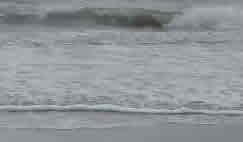 |
1. The shoreline
Sand accumulates on the beach from longshore drift or onshore currents. At low tide, the sand dries out allowing the prevailing winds to move the loose sand up the beach. Most moves by saltation in a series of short hops but strong winds may be powerful enough to carry the finer sand grains for longer distances. |
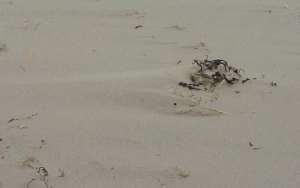 |
2. Embryo Dunes
Sand is continuously moving around at the top of the beach and it needs an obstruction to break the force of the wind, so that sand begins to accumulate. Seaweed, dead seabirds, driftwood etc may all serve this purpose. These embryo dunes may disappear as quickly as they form but some may eventually be colonised by plants which stabilise the sand. |
Conditions here are very extreme, with high pH values (over 8), rapid drainage, no humus, high wind speed and lots of salt spray. Consequently dunes may not grow higher than 1m. |
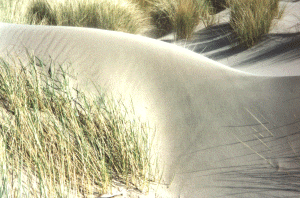 |
3. The Fore Dune
The first plants to colonise the foredunes are lyme grass, sea couch grass and marram grass. These plants are drought-resistant and capable of withstanding burial by the shifting sand. As they grow up through the sand, they help trap more sand and so the dunes increase in height. Here the dunes may reach up to 5 metres. |
The marram grass which may reach 50-120cms. in height, has an extensive root system which helps to bind the sand together and young shoots grow up from the spreading roots or rhizomes ( bacteria on root nodules that fix atmospheric nitrogen). |
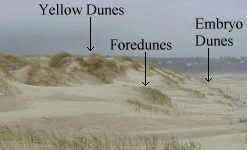 |
4. Yellow Dunes
The yellow dunes begin to show a greater diversity of plants as conditions become more favourable. As plants die and decay, a humus layer builds up and this traps both water and nutrients. The pH is now only slightly alkaline (about 7.5), there is more shelter and less salt spray. Marram usually still dominates the vegetation but as can be seen in the |
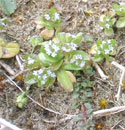 picture left, other plants are taking hold on the stabilised surface. Plants may include creeping fescue, sand sedge, mosses, lichens, sea holly and sea spurge.The dunes by this stage may well have reached between 5-10 metres high. As much as 80% of the sand surface may now be vegetated. Additionally, rabbits (bunnies!) and other mammals may add their droppings to help enrich the developing soil. picture left, other plants are taking hold on the stabilised surface. Plants may include creeping fescue, sand sedge, mosses, lichens, sea holly and sea spurge.The dunes by this stage may well have reached between 5-10 metres high. As much as 80% of the sand surface may now be vegetated. Additionally, rabbits (bunnies!) and other mammals may add their droppings to help enrich the developing soil.
|
 |
5. Grey Dunes
The grey dunes are much more stable and mosses and lichens fill the few remaining spaces between plants so that vegetation cover may reach 100%. Marram grass becomes less common and appears now in isolated patches. Small shrubs (brambles, gorse, buckthorn) appear for the first time. There is shelter from the harshest winds, humus is beginning to darken the surface layers and a true soil begins to form. |
Soil pH is increasingly acid and heathers may take advantage of the acid conditions. Water content is still low and plants have to search for water with their spreading root systems. These large dunes are commonly 10 metres in height and wider than those dunes nearer the shore. Note the rabbit burrows that have started to appear in this picture, above. |
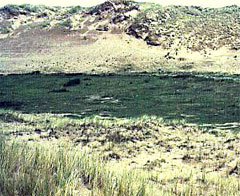 |
6. Dune Slack
The dune slacks are found in between the more mature dunes where the water table reaches the surface causing seasonal (and sometimes) permanent waterlogging and surface water. Plants which are well adapted to these damp, sheltered hollows include rushes, sedges, cotton grass and creeping willow. If decay is slow, a peaty soil may develop.
|
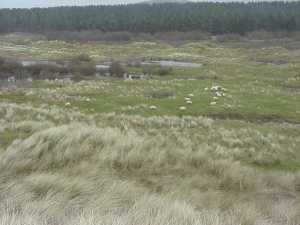 |
7. Mature Dunes
The most mature dunes are found several hundred metres from the shore. Left undisturbed these dunes develop a soil which can support shrubs and trees including hawthorn, ash and birch. Humans may, as in the picture on the left, plant fast-growing conifers which flourish in the sandy soil. Eventually an oak climax vegetation may develop. |
| |
|
| |
|